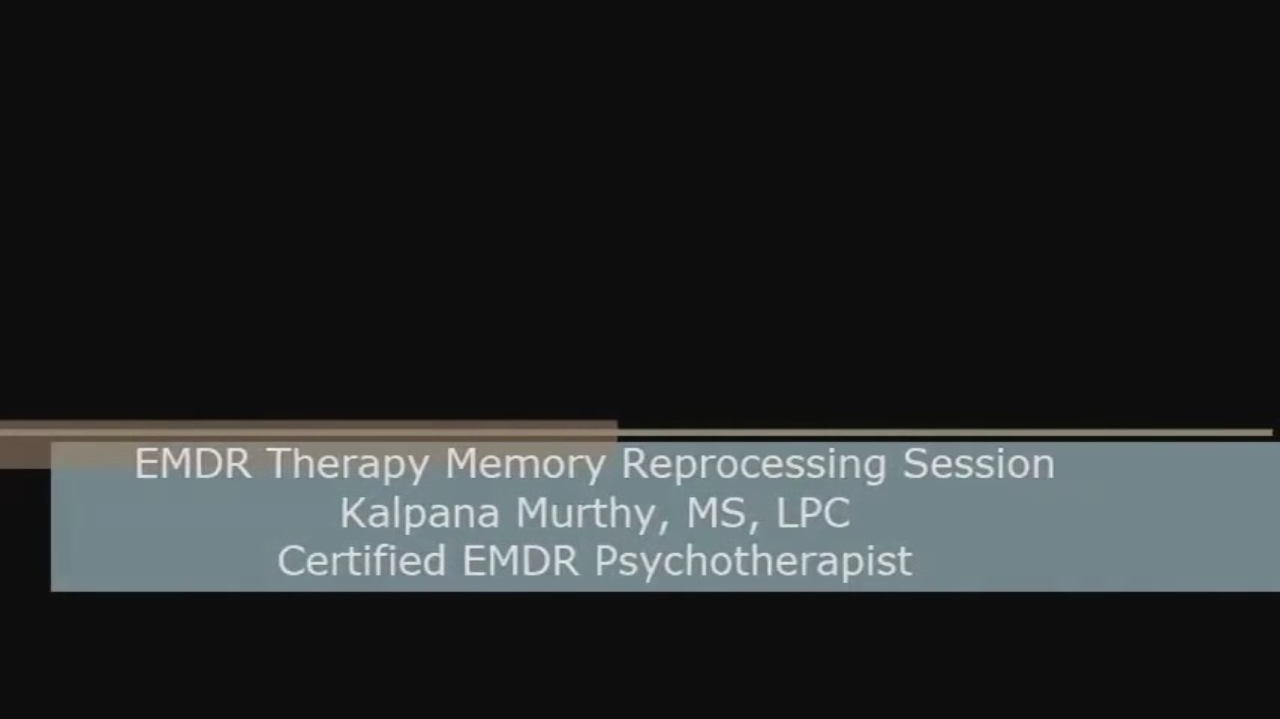What is EMDR? – Video Transcript
Hi, my name is Kalpana Murthy, and I’m a psychotherapist in private practice in Atlanta, Georgia. I’m here today to talk about one of my favorite subjects, and that is, What is EMDR therapy? Even though EMDR has been around for 25 years and has helped millions of people worldwide get past their past, there are still so many people who don’t know about it. As a result, they’re struggling with something that could go away in just a few sessions with EMDR therapy.
I first learned about EMDR even before I became a therapist, when a friend told me about it. I had a powerful, helpful experience with my own EMDR therapy.

My experience, combined with what I’ve seen in my therapy practice where over the years I have worked with hundreds of clients and have seen how they quickly healed from a range of problems that they had been trying lots of ways to solve and had just gotten to the point where they were feeling stuck and that they kind of maybe had to live with it. The good news is, you don’t have to live with it.
What is EMDR? It stands for Eye Movement Desensitization and Reprocessing, but a simpler way to think about it, is it’s memory reprocessing. When we talk about processing a memory with EMDR, we don’t mean talking about the memory in detail the way you would in traditional talk therapy. Processing with EMDR means we are setting up the brain’s natural learning state and the brain’s information processing model. Then when we’ve accessed that memory in the brain, we are facilitating the brain’s process to link that upsetting memory up with other information in your brain, so that the memory is transformed, adapted, and is stored in your brain in a way that it’s useful for you and is no longer contributing to problems such as anxiety, or depression, or negative self-talk, or causing you to have problems in your relationships or your career, or to cope with stress in ways that you’d rather not have.
What EMDR is based on is that the brain has a mechanism where what it does is, it takes the information of our experiences of the day, and at night, while we’re sleeping, during rapid eye movement sleep or REM sleep, our brain sorts through the experiences of the day and says, “Hey, what information from the day does this person need to hold onto for their well-being, for their survival?” The brain takes that information, and links it up with other information, so we learn from the day’s experience. During that same process the brain says, “Hey, what are the experiences of the day that are kind of useless?” We don’t need to remember those kind of things. They’re not serving us well.
That’s why you can go to bed at night, and maybe something is bothering you from the day, maybe something somebody said or did is frustrating or annoying you. Maybe there’s a problem you’ve been trying to solve, and you can’t figure it out. Maybe you’ve been studying for an exam, and you’re having trouble learning the information. Then have you ever noticed you wake up the next day and whatever was bothering you, doesn’t seem as upsetting? Maybe you figured out the solution to that problem or you’ve learned the material you were studying for. That’s because of that natural process that happens at night where our brain takes the information of the day, and learns it, and stores it.
Here’s what we know. When we have certain types of upsetting, disturbing, or traumatic experiences happen, the brain stores the information in a way that doesn’t serve us. When we have those types of experiences, the brain kind of gets stuck on them, meaning it takes all of the information that happened during that experience, and that’s all the sensory information, any physical sensations you had at the time it happened, as well as how it made you feel about yourself. The brain kind of stores it. I want you to almost think about it as an ice cube. What’s stuck and frozen in that ice cube is all that information associated with that memory.
The brain is doing that for a reason. When we have these types of upsetting experiences happen to us, we feel that we’re not going to survive in some way. These upsetting experiences don’t have to be what people consider major trauma where your physical safety or your life is at stake. Things that make us feel uncomfortable emotionally, such as experiences where we feel embarrassed, or ashamed, or criticized, or not good enough, those types of experiences are equally disturbing to our well-being and our survival. Our brain doesn’t really make a distinction between something that is a threat to our physical well-being or emotional well-being. The brain says, “Hey, we want this person to remember this experience, so in the future if a similar experience happens, they can protect themselves, they can survive.
But, sometimes the way that information gets stored isn’t serving us, so what we are doing with EMDR is we are identifying memories that are contributing to present day issues. Often you may not know what those are, but there’s a process that we follow as part of the EMDR protocol to identify what the root cause is of some of the issues you may want to work on. Then while you are focusing or thinking about the memory and connecting to the feelings that come up for you present day when you’re thinking about the memory, you are engaging the right and left hemispheres of your brain.
One way of doing that is by moving your eyes back and forth from right to left. That’s the EM (eye movement) part of EMDR, and there are other ways that we can engage the right and left hemispheres of the brain. You can be wearing an audio headset and you’ll hear a tone alternating in your right and left ear, or you can hold a small battery operated device in each of your hands, and you’ll have a physical tapping sensation. All three of those things are doing the same thing, trying to replicate what happens not only during rapid eye movement sleep at night, but also what happens with working memory. During that process while you are having an EMDR session, your brain is connecting that stuck, frozen information with all the other information you have in your brain, and the wisdom and perspective you have now. It’s doing what it does at night, meaning what is useful about that memory will be held onto, and what is useless will be discarded.
At the end of the EMDR session when you think about the memory in the future, it may have been distressing in some way when you started the EMDR session, but as a result of the connections, and the learning, and the insights that have happened during your EMDR session, that memory will not feel as emotionally distressing and won’t have the physical charge that it may have had. That’s the D part of the EMDR, the desensitization. The R part, the reprocessing means that the gut level negative belief that you had made about yourself at the time of the experience that feels true at the start of the EMDR session, maybe rationally you know it’s not true but at a gut level it feels true, that belief would have also shifted because of the learning that would have taken place during the EMDR processing.
That negative self- talk that has held you back in your life or caused you problems, that belief will no longer feel true. It will be replaced by something that you’ve generated on your own during the processing. It will feel true to you not because you’re telling yourself, “Hey, I need a positive affirmation around that. I need to think positively,” but it will feel true because of the learning that has happened.
One of the things that I know for sure based on what I’ve witnessed in my own EMDR work as well as working with all the clients that I’ve worked with, with EMDR, is that time and talk alone does not always take care of upsetting experiences from the past. That’s because of the way those experiences got stuck and stored in your brain. That is why we need to sort of engage the brain’s information processing model to move that information and change the form of it, so it’s stored in a way that is useful to you and enhances your well-being.
If you would like to learn more about EMDR therapy, please click here. I hope this information has been of help to you or somebody you know. I look forward to connecting with you soon. Thank you.

